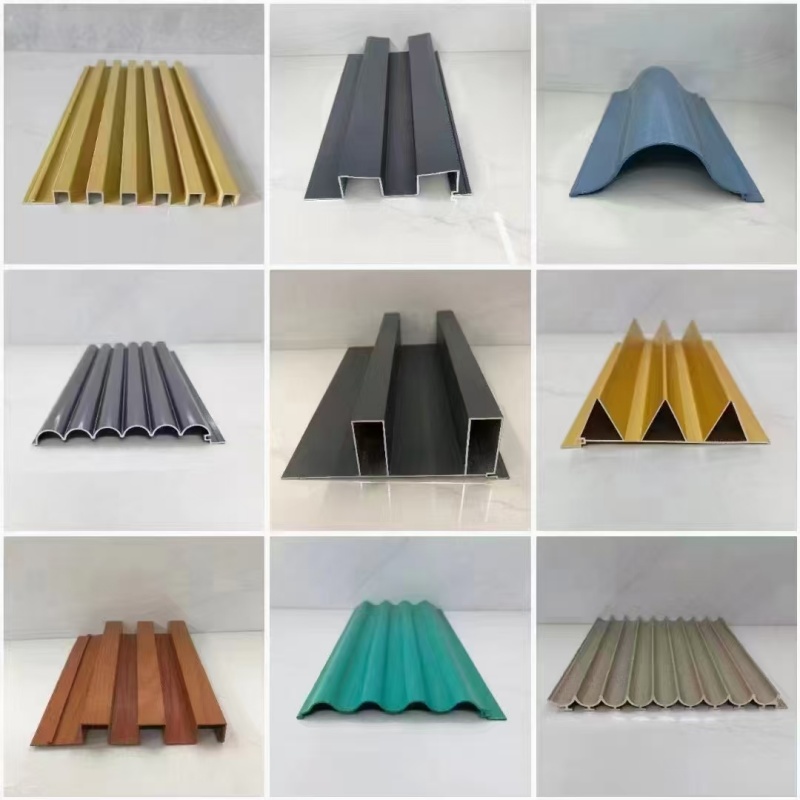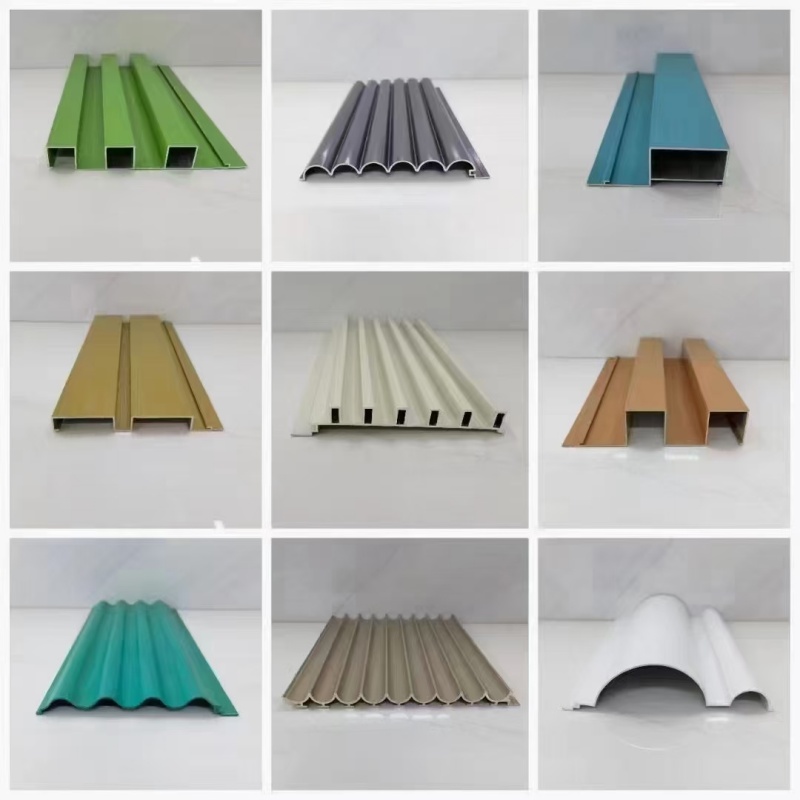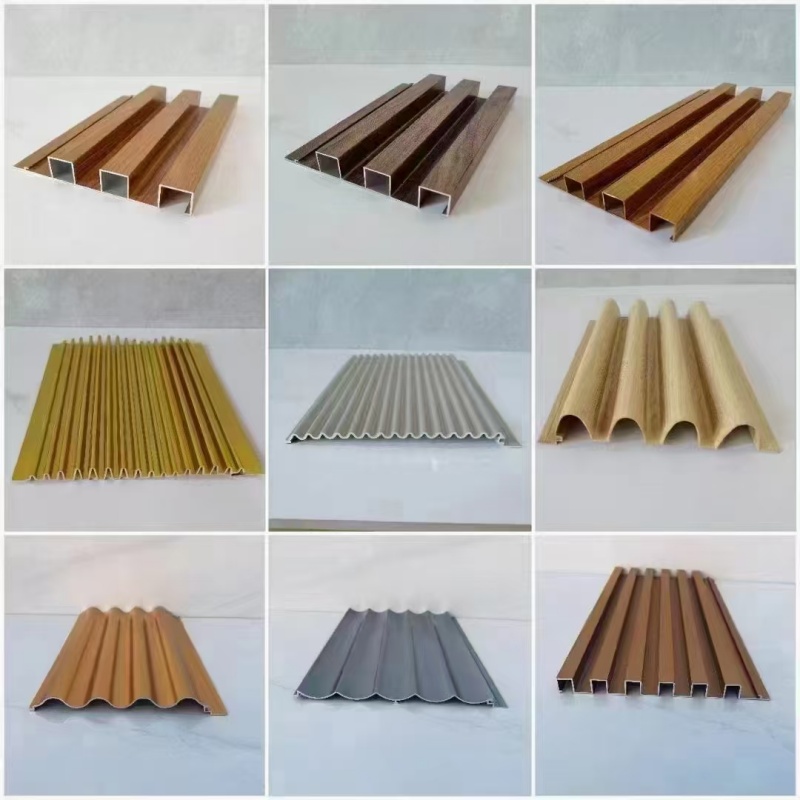Aluminum extrusion is a pivotal process in modern manufacturing, transforming raw aluminum into a myriad of structural and functional components. This technique involves forcing aluminum through a die to create objects with a fixed cross-sectional profile, a method that is both efficient and versatile. The importance of the aluminum extrusion process cannot be overstated, as it plays a critical role in numerous industries, from construction to automotive, and even electronics.
The aluminum extrusion process is essential for creating components that are lightweight yet strong, offering significant advantages in applications where weight reduction is crucial. For instance, in the automotive industry, reducing vehicle weight is key to improving fuel efficiency, and aluminum extrusions provide the perfect solution. Similarly, in construction, the process allows for the creation of durable, corrosion-resistant structures that can withstand harsh environmental conditions.
Understanding the aluminium extrusion meaning is vital for industries that rely heavily on aluminum components. This knowledge not only helps in optimizing the manufacturing process but also in selecting the right materials and techniques for specific applications. As industries continue to innovate and demand more from their materials, the role of aluminum extrusion becomes increasingly significant. By grasping the intricacies of this process, manufacturers can enhance product quality, reduce costs, and improve overall efficiency.
As we delve deeper into the specifics of how aluminum extrusion works, it becomes clear why this process is a cornerstone of modern manufacturing. It combines the inherent properties of aluminum—such as its formability and strength—with the precision of extrusion techniques, resulting in products that are both functional and aesthetically pleasing. This guide aims to provide a comprehensive understanding of aluminum extrusion, exploring its applications, challenges, and future trends.

Aluminum extrusion is a transformative process that turns aluminum billets into a variety of shapes and profiles, which are then used in numerous applications. To define extruded aluminum, one must understand that it is a material that has been shaped by forcing it through a die, a tool that determines the cross-sectional profile of the final product. This process is akin to squeezing toothpaste out of a tube, where the shape of the opening dictates the form of the paste.
The aluminum extrusions definition encompasses several key steps. Initially, an aluminum billet, which is a cylindrical log of aluminum, is heated to a temperature that makes it malleable. This preheating is crucial as it allows the aluminum to be easily shaped without cracking. Once heated, the billet is placed into a press, where a hydraulic ram applies immense pressure, forcing the aluminum through the die. The shape of the die opening precisely dictates the profile of the extruded aluminum, which can range from simple to highly complex forms.
Dies play a pivotal role in ensuring the quality and accuracy of the extrusion. These are typically made from hardened steel and are designed with great precision to accommodate different shapes, including solid, hollow, and semi-hollow profiles. The choice of die influences the extrusion process significantly, as it must withstand high pressures and temperatures while ensuring the material flows smoothly to avoid defects.
Different extrusion techniques, such as direct and indirect extrusion, also impact the final product. Direct extrusion involves pushing the billet through a stationary die, while in indirect extrusion, the die moves towards the stationary billet. Each method has its advantages, with indirect extrusion often resulting in less friction and therefore less wear on the die and the billet.
Understanding these principles and the significance of dies is essential for anyone looking to optimize the aluminum extrusion process. This knowledge not only aids in producing high-quality extrusions but also in selecting the best techniques and materials for specific industrial applications. As we proceed, we will delve into a detailed breakdown of the aluminum extrusion process, exploring each step and its impact on the final product.
Understanding how aluminum extrusion is made involves delving into a meticulous process that transforms raw aluminum into versatile, high-quality profiles. The journey begins with the preparation of the aluminum billet, a crucial first step that sets the stage for the entire extrusion process.
The aluminum billet, typically a cylindrical log, is first homogenized and softened through a controlled heating process. This step is essential to ensure the billet becomes malleable without losing its structural integrity. The billet is heated to temperatures between 400-480°C (750-900°F), a range that maintains its solid form while making it pliable enough for extrusion. The proper preheating of the billet is critical, as it directly influences the ease with which the aluminum can be shaped and the quality of the final extruded product.
Once the billet reaches the desired temperature, it is transferred to the extrusion press. Here, a powerful hydraulic ram applies significant pressure, forcing the billet through a die. This die is a specially designed tool that shapes the aluminum into its intended cross-sectional profile. As the aluminum is pushed through the die, it emerges as a long piece with a uniform cross-section, showcasing the versatility of the extruded aluminum process. The complexity of the die design allows for a wide variety of shapes, from simple rods to intricate profiles used in various industries.
After extrusion, the aluminum profile must be cooled rapidly to maintain its shape and enhance its mechanical properties. This cooling process can be achieved through air or water quenching, depending on the desired characteristics of the final product. Once cooled, the profiles are stretched to straighten them and relieve any internal stresses that may have developed during extrusion. This step ensures that the profiles maintain their structural integrity and meet precise dimensional specifications.
Following the initial cooling, the profiles often undergo heat treatment to further enhance their mechanical properties. This process, known as aging, involves reheating the profiles to specific temperatures to achieve the desired temper, such as T5 or T6, which increases strength and durability. The final step involves cutting the profiles to the required lengths and applying any surface finishes, such as anodizing or powder coating, to improve appearance and corrosion resistance.
By understanding each step of the aluminum extrusion process, from the initial billet preparation to the final finishing touches, we gain insight into how this transformative process creates high-quality, customized aluminum profiles. As we move forward, we will explore the technological advancements that are continuously shaping the future of aluminum extrusion.
In recent years, the aluminum extrusion industry has witnessed significant technological advancements that are revolutionizing the aluminum extrusion process. These innovations not only enhance the efficiency and precision of production but also open new possibilities for design and application, making the process more versatile and cost-effective.
One of the most exciting developments is the integration of 3D printing in die manufacturing. Traditional die-making processes can be time-consuming and costly, especially when creating complex shapes. However, with 3D printing, we can produce intricate dies quickly and affordably, allowing for greater design flexibility. This advancement is particularly beneficial for producing custom profiles that require unique geometries not feasible with conventional methods.
Another breakthrough in aluminum extrusion technology is the use of hot and hybrid extrusion techniques. Hot extrusion involves processing aluminum at higher temperatures, which increases material pliability, enabling the creation of thinner and more complex profiles. Hybrid extrusion, which combines traditional methods with additive manufacturing, allows for the production of components with intricate internal structures, reducing the need for additional machining and assembly.
Material innovations, such as nanostructured aluminum, are also shaping the future of the extrusion aluminium process. By incorporating nanoparticles into the aluminum matrix, we can enhance the strength and ductility of the extruded products. This development is particularly advantageous for industries like aerospace and automotive, where high strength-to-weight ratios are critical.
The integration of automation and artificial intelligence (AI) is transforming how aluminum extrusion processes are managed. AI-driven systems optimize the extrusion parameters, reducing waste and improving product quality. Additionally, robotic automation enhances precision and efficiency, minimizing human error and increasing throughput. These technologies also facilitate real-time monitoring and predictive maintenance, ensuring consistent production quality and reducing downtime.
These advancements in aluminum extrusion technology are not just improving current manufacturing capabilities but are also paving the way for future innovations. As we continue to explore these emerging technologies, the potential for creating more efficient, precise, and sustainable extrusion processes is vast. In the next section, we will delve into the diverse applications of extruded aluminum across various industries, showcasing its versatility and importance.

The extruded aluminum process has revolutionized numerous industries by providing a material that is both versatile and durable. As we delve into the various applications of extruded aluminum, it becomes evident why this material is highly favored across different sectors. Its unique properties make it an ideal choice for industries such as construction, automotive, and electronics, where strength, lightweight characteristics, and corrosion resistance are paramount.
In the construction industry, extruded aluminum is used extensively for building frameworks, window frames, and curtain walls. Its strength-to-weight ratio is particularly beneficial in high-rise buildings, where reducing structural weight without compromising strength is crucial. Aluminum's natural corrosion resistance ensures longevity and minimal maintenance, making it a cost-effective choice for architects and builders.
The automotive industry has long relied on how extruded aluminum is made to meet the increasing demands for fuel efficiency and safety. Aluminum's lightweight nature contributes to significant weight reductions in vehicles, enhancing fuel economy and reducing emissions. Moreover, its ability to absorb impact energy makes it an excellent choice for crash management systems, providing enhanced safety features in modern vehicles.
In the realm of electronics, extruded aluminum is prized for its excellent thermal and electrical conductivity. It is commonly used in heat sinks and electronic enclosures, where efficient heat dissipation is critical. Additionally, aluminum's non-magnetic properties make it suitable for high-voltage applications, ensuring safety and reliability in electrical systems.
Beyond these industries, extruded aluminum finds applications in aerospace, marine, and renewable energy sectors. In aerospace, its lightweight and durable nature supports the design of fuel-efficient aircraft. In marine environments, aluminum's resistance to saltwater corrosion extends the lifespan of ships and offshore structures. Furthermore, in renewable energy, aluminum extrusions are used in solar panel frames and wind turbine components, contributing to sustainable energy solutions.
The myriad applications of extruded aluminum highlight its indispensable role in modern manufacturing. Its adaptability and beneficial properties continue to drive innovation across various fields. As we explore the challenges and considerations in the aluminum extrusion process, it becomes clear how crucial it is to optimize these applications for maximum efficiency and effectiveness.
The aluminum extrusion process is not without its challenges, which can significantly impact production efficiency and product quality. As we navigate through these hurdles, it's essential to identify the key issues that manufacturers face and explore potential solutions to optimize the process.
One of the primary challenges in aluminum profile manufacturing is dealing with material defects. These can arise from inconsistencies in raw material quality, such as variations in chemical composition or impurities. Such defects can compromise the structural integrity of the final product, leading to failures in critical applications. To combat this, manufacturers must implement rigorous quality control measures, ensuring that raw materials meet stringent standards before entering the production line. Advanced inspection technologies, such as X-ray and ultrasonic testing, can help detect and eliminate defects early in the process.
Cost is another significant consideration in the aluminum extrusion industry. The process requires substantial energy inputs, particularly for heating and pressing the aluminum billets. Rising energy costs can therefore inflate production expenses, challenging manufacturers to maintain competitive pricing. To address this, companies are increasingly investing in energy-efficient technologies and practices. For instance, optimizing furnace temperatures and employing waste heat recovery systems can reduce energy consumption and lower costs.
Supply chain disruptions and labor shortages further complicate the aluminum extrusion landscape. Political tensions, tariffs, and market fluctuations can lead to raw material scarcity, affecting production schedules and output. In response, manufacturers are seeking to diversify their supply chains and form strategic partnerships to ensure a steady flow of materials. Additionally, the labor market presents challenges as the industry struggles to attract skilled workers. Automation and AI integration offer potential solutions, enabling companies to maintain productivity levels despite workforce limitations.
Environmental regulations are becoming increasingly stringent, requiring manufacturers to minimize emissions and waste. Compliance with these regulations can be costly and complex, but it also presents an opportunity for innovation. By investing in cleaner technologies and sustainable practices, companies can not only meet regulatory requirements but also enhance their market reputation and appeal to environmentally conscious consumers.
In conclusion, while the aluminum extrusion process faces numerous challenges, there are viable strategies to overcome them. By prioritizing quality control, optimizing resource use, and embracing technological advancements, manufacturers can enhance their operations and continue to meet the growing demand for aluminum profiles. As we transition to discussing common challenges, we will explore these areas further, offering insights into overcoming obstacles and optimizing the extrusion process for better results.
As we conclude our exploration of the aluminum extrusion process, it's evident that this method is integral to the advancement of numerous industries. From its pivotal role in manufacturing lightweight automotive components to its application in sustainable construction, aluminum extrusion has proven to be a versatile and indispensable technology. The process not only enhances the strength and durability of aluminum products but also allows for the creation of complex shapes that meet diverse industrial needs.
Reflecting on the advancements discussed, it's clear that the future of aluminum extrusion is promising. Emerging technologies such as 3D printing for die manufacturing and the integration of AI and robotics are poised to revolutionize the industry. These innovations offer increased precision, efficiency, and customization, making the definition of extruded aluminum even more expansive. Additionally, advancements in material science, like the development of nanostructured aluminum, promise to enhance the mechanical properties of extruded products, opening new possibilities in sectors that demand high performance and lightweight materials.
Looking ahead, staying informed about these trends is crucial for anyone involved in industries reliant on aluminum components. The continuous evolution of extrusion techniques and materials not only promises to meet current demands but also to anticipate future challenges and opportunities. As we embrace these technological advancements, the aluminum extrusion industry is set to play a pivotal role in shaping a more sustainable and efficient manufacturing landscape.
In our next section, we will introduce Anhui Shengxin New Materials Co., Ltd., a key player in the aluminum extrusion market, and explore how they are leveraging these advancements to offer customized solutions. Stay tuned to discover how industry leaders are setting the benchmark for quality and innovation in aluminum extrusion.

As we delve into the landscape of aluminum extrusion, it is essential to recognize the pivotal role that industry leaders like Anhui Shengxin New Materials Co., Ltd. play in advancing the capabilities and applications of this vital process. Established in 2003, Shengxin has grown to become a powerhouse in the aluminum extrusion industry, renowned for its cutting-edge technology and commitment to quality.
With over 100 production lines, Shengxin stands as the largest aluminum profiles manufacturer in Anhui Province, China. Our extensive range of production capabilities includes fusion casting, extrusion, anodizing, and various painting techniques like electrophoresis and powder coating. These facilities enable us to produce an impressive 100,000 tons of aluminum profiles annually, ensuring we meet the diverse needs of our clients with precision and efficiency.
Our state-of-the-art equipment, including a 5500-ton extrusion line—the largest in Anhui Province—allows us to deliver high-quality aluminum profiles tailored to specific industry requirements. These capabilities are complemented by our deep processing workshops, which feature advanced CNC machining services that cater to complex, customized designs.
We specialize in producing eco-friendly and energy-saving profiles for various applications, including curtain walls, windows, and doors. Our high-tech industrial profiles are used in cutting-edge sectors like new energy vehicles and rail transit, where precision and durability are paramount.
If you're seeking customized aluminum solutions, Shengxin offers unparalleled expertise and flexibility. Our ability to adapt to specific project needs, whether through unique design specifications or specialized surface treatments, positions us as a trusted partner in the aluminum extrusion industry.
We invite you to explore our offerings and discover how Shengxin can support your next project with high-quality, innovative aluminum solutions. Our commitment to excellence ensures that we not only meet but exceed the expectations of our clients, delivering products that stand the test of time.
 dịch vụ trực tuyến
dịch vụ trực tuyến 0086 136 3563 2360
0086 136 3563 2360 sales@sxalu.com
sales@sxalu.com +86 136 3563 2360
+86 136 3563 2360